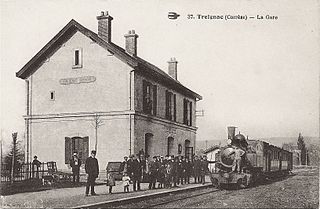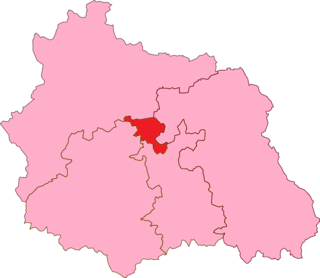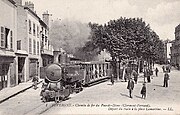
Clermont-Ferrand is a city and commune of France, in the Auvergne-Rhône-Alpes region, with a population of 147,284 (2020). Its metropolitan area had 504,157 inhabitants at the 2018 census. It is the prefecture (capital) of the Puy-de-Dôme département. Olivier Bianchi is its current mayor.

Puy-de-Dôme is a department in the Auvergne-Rhône-Alpes region in the centre of France. In 2021, it had a population of 662,285. Its prefecture is Clermont-Ferrand and subprefectures are Ambert, Issoire, Riom, and Thiers.

A rack railway is a steep grade railway with a toothed rack rail, usually between the running rails. The trains are fitted with one or more cog wheels or pinions that mesh with this rack rail. This allows the trains to operate on steep grades above 10%, which is the maximum for friction-based rail. Most rack railways are mountain railways, although a few are transit railways or tramways built to overcome a steep gradient in an urban environment.

The Fell system was the first third-rail system for railways that were too steep to be worked by adhesion on the two running rails alone. It used a raised centre rail between the two running rails to provide extra traction and braking, or braking alone. Trains were propelled by wheels horizontally applied and retracted by springs onto the centre rail, controlled from the cab, as well as by the normal running wheels. In practice, the running wheels could be allowed to run freely to reduce wear, but the centre brake shoes needed to be replaced frequently. For example: the locomotives' shoes were replaced after each journey on the Mont Cenis Pass Railway. Extra brake shoes were fitted to specially designed or adapted Fell locomotives and brake vans, and for traction the prototype locomotive had an auxiliary engine powering the horizontal wheels. The Fell system was developed in the 1860s and was soon superseded by various types of rack railway for new lines, but some Fell systems remained in use into the 1960s. The Snaefell Mountain Railway still uses the Fell system for (emergency) braking, but not for traction.

Chamalières is a commune in the Puy-de-Dôme department, Auvergne-Rhône-Alpes, central France.

The Arrondissement of Issoire is an arrondissement of France in the Puy-de-Dôme department in the Auvergne-Rhône-Alpes region. It has 134 communes. Its population is 78,866 (2018), and its area is 2,296.7 km2 (886.8 sq mi).

Serge Godard is a French politician. He represented the French department of Puy-de-Dôme in the French Senate from September 1998 to September 2001 and again from March 2010 to September 2011.

Aubière is a commune located in the department of Puy-de-Dôme in the Auvergne-Rhône-Alpes region in southeast France. As of 2017 its population was 10,061.

La Tour-d'Auvergne is a commune in the Puy-de-Dôme department in Auvergne in central France.
Michèle André is a French politician and member of the Socialist Party. Director of a public medico-social establishment, she was a Senator for the Puy-de-Dôme department and president of the Senate Finance Committee until October 2017.

Trams in France date from 1837 when a 15 km steam tram line connected Montrond-les-Bains and Montbrison in the Loire. With the development of electric trams at the end of the 19th century, networks proliferated in French cities over a period of 15 years. Although nearly all of the country's tram systems were replaced by bus services in the 1930s or shortly after the Second World War, France is now in the forefront of the revival of tramways and light rail systems around the globe. Only tram lines in Lille and Saint-Étienne have operated continuously since the 19th century; the Marseille tramway system ran continuously until 2004 and only closed then for 3 years for extensive refurbishment into a modern tram network. Since the opening of the Nantes tramway in 1985, more than twenty towns and cities across France have built new tram lines. As of 2024, there are 28 operational tram networks in France, with 3 more planned. France is also home to Alstom, a leading tram manufacturer.

The PO Corrèze (POC) is a former metre-gauge railway in the Corrèze department in central France. The concession was granted to the Chemin de Fer de Paris à Orléans (PO) and constructed by the Société de Construction des Batignolles. Together with the Chemin de fer du Blanc-Argent and the Blois à Saint Aignan, they formed the metre-gauge network of the PO.

The Société de Construction des Batignolles was a civil engineering company of France created in 1871 as a public limited company from the 1846 limited partnership of Ernest Gouin et Cie.. Initially founded to construct locomotives, the company produced the first iron bridge in France, and moved away from mechanical to civil engineering projects in France, North Africa, Europe, and in East Asia and South America.

The Clermont-Ferrand tramway is a transit system located in the city of Clermont-Ferrand in the Auvergne-Rhône-Alpes region of France. It is a Translohr system, meaning it is guided by a single rail and powered by electricity from overhead wires.
The following is a timeline of the history of the city of Clermont-Ferrand, France.
The Clermont-Ferrand tramway was a tram system in the French city of Clermont-Ferrand between 1890 and 1956. A new system came into operation in 2006.

The 1st constituency of the Puy-de-Dôme is a French legislative constituency in the Puy-de-Dôme département. Like the other 576 French constituencies, it elects one MP using a two-round election system.
France Bleu Pays d'Auvergne is a generalist public service radio station. It broadcasts in the departments of Puy-de-Dôme, Allier, Cantal and most of western Haute-Loire.

The Compagnie de l'Ouest algérien (OA) was a railway company created in 1881 to build and operate a network in the Department of Oran.





















